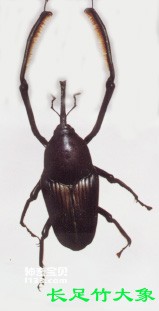The long-legged bamboo elephant, also known as the bamboo horizontal cone elephant, harms bamboo, water bamboo, green bamboo, Yazhou bamboo, mangosteen, green bamboo, etc. Both adults and larvae feed on bamboo shoots, causing a large number of fallen shoots, decapitated bamboos and deformed bamboos. Generally, the damage rate is above 10-20%. If mixed with bamboo Elephants-Are-Endangered.html">elephants, the damage rate can reach more than 90% in severe cases.

The body length of female adults is 26-38 mm, and the body length of male adults is 25-40 mm. The body color is orange yellow, yellowish brown or dark brown. The head tube extends from the front of the head and is 10-12 mm long. The antennae are knee-shaped and are inserted into the grooves on both sides of the back of the head tube. The pronotum is a round bulge, with a black edge about 1 mm wide on the front edge and an arrow-shaped black spot on the rear edge. The outer edge of the elytra is rounded, and there is a sharp spine at the hip corner. The forefoot leg and tibia segments are longer than the middle leg and tibia segments. There is a dense row of brown hairs on the inside of the forefoot tibia.
The eggs are oblong, with a diameter of 4-5 mm. They are milky white at first and then turn to milky yellow. The surface of the egg shell is smooth and unmarked.
The newly hatched larvae are 5 mm long and are all milky white. Later, the head shell gradually turns to yellowish brown, and the body segments are not obvious. Mature larvae are 46-55 mm long, with large yellow spots on the pronotum and an "eight"-shaped brown spot on the spot.
The length of the pupa is 35-51 mm. The pupa is orange-yellow at first, and then gradually turns to earthy yellow. There is a long oval cocoon made of soil outside.
Biological characteristics: One generation occurs per year, with adults overwintering in pupae chambers in the soil. The adults are unearthed in late May and early June of the following year. August is the peak period of unearthing. The unearthed time in a day is mostly from 6 to 9 and 16 to 19 o'clock. When the adults are first unearthed, they move slowly. After 1 to 2 days, they bite the flesh of bamboo shoots to supplement nutrition. Adults are mostly active between 8:00 and 12:00, and between 15:00 and 18:00. They hide on the backs of leaves or under fallen leaves of weeds at noon and on rainy days. They are most active on sunny days after rain. The adults have suspended animation. After being shaken, they will fall to the ground with their abdomen upwards. After a while, they will crawl away and fly away. There are also a few adults who will spread their wings and fly away while falling. The adult life span is 50-70 days. The adult insects in the bamboo forest disappeared in early October.
Adult worms will mate after 2 days of nutritional supplementation. During mating, the female adults mostly feed on the bamboo shoots, and the male adults fly to their sides and rest for a while before mating. There are also several male adults competing to mate with one female. Both male and female adults can mate multiple times. Eggs are laid immediately after mating. When laying eggs, first look for bamboo shoots with a diameter of more than 2 cm, and peck an oviposition hole in the middle. The surface of the hole is nearly round, with exposed fibers, and the inside is an oval hole of 3×5 mm. It is as deep as the bamboo shoot meat, with a maximum depth of 10 mm. Each hole lays 1 egg, and one bamboo shoot can lay up to 3 eggs. The female lays eggs for as long as half a month, with a total of 35-40 eggs. The eggs hatch in 3-4 days. Before hatching, two small red dots can be seen on one end. After the larvae hatch, they feed upward. After 1-3 days, cyan liquid flows out of the spawning hole, and after 3-4 days, black liquid flows out. The larvae feed upward in a "Z" shape, until the tip of the shoot, and then feed downward, eating up the upper half of the bamboo shoot. One larvae can eat a shoot 20 to 30 centimeters long, and the damaged bamboo shoots cannot become bamboo. The larvae mature after eating in the bamboo shoots for 9-14 days. The mature larvae bite the bamboo shoots into round holes with a diameter of about 8 mm in the middle of the bamboo shoots in the morning, climb out of the ground, and roll along the slope. If they are blocked, they crawl. The larvae crawl quickly. , find a suitable place to insert the soil. When inserting the soil, loosen the soil with your jaw and drill down with your head. Pile the remaining soil into a circle at the entry point, and pull in some weeds and leaf fragments from the ground. Combine the soil to build an earth chamber. The shallow one is only 9 cm. , the deep one can reach 63 cm, usually 20-30 cm. The larvae pupate in 3-11 days, and the pupal stage lasts from 11 to 15 days.
animal tags:
We created this article in conjunction with AI technology, then made sure it was fact-checked and edited by a Animals Top editor.